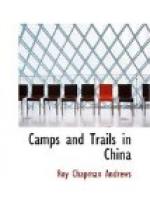On our first day in the temple Heller went up the Snow Mountain for a reconnoissance and the party secured a fine porcupine. It is quite a different animal from the American tree porcupines and represents a genus (Hystrix) which is found in Asia, Africa, and southern Europe. This species lives in burrows and, when hunting big game, we were often greatly annoyed to find that our dogs had followed the trail of one of these animals. We would arrive to see the hounds dancing about the burrow yelping excitedly instead of having a goral at bay as we had expected.
Some of the beautiful black and ivory white quills are more than twelve inches long and very sharp. A porcupine will keep an entire pack of dogs at bay and is almost sure to drive its murderous weapons into the bodies of some of them unless the hunters arrive in a short time. The Mosos eat the flesh which is white and fine.
Although we were only twelve miles from Li-chiang the traps yielded four shrews and one mouse which were new to our collection. The natives brought in three bats which we had not previously seen and began a thriving business in toads and frogs with now and then a snake.
The temple was an excellent place for small mammals but it was evident that we would have to move high up on the slopes of the mountain if gorals and other big game were to be obtained. Accordingly, while Heller prepared a number of bat skins we started out on horseback to hunt a camp site.
It was a glorious day with the sun shining brilliantly from a cloudless sky and just a touch of autumn snap in the air. We crossed the sloping rock-strewn plain to the base of the mountain, and discovered a trail which led up a forested shoulder to the right of the main peaks. An hour of steady climbing brought us to the summit of the ridge where we struck into the woods toward a snow-field on the opposite slope. The trail led us along the brink of a steep escarpment from which we could look over the valley and away into the blue distance toward Li-chiang. Three thousand feet below us the roof of our temple gleamed from among the sheltering pine trees, and the herds of sheep and cattle massed themselves into moving patches on the smooth brown plain.
We pushed our way through the spruce forest with the glistening snow bed as a beacon and suddenly emerged into a flat open meadow overshadowed by the ragged peaks. “What a perfectly wonderful place to camp,” we both exclaimed. “If we can only find water, let’s come tomorrow.”
The hunters had assured us that there were no streams on this end of the mountain but we hoped to find a snow bank which would supply our camp for a few days at least. We rode slowly up the meadow reveling in the grandeur of the snow-crowned pinnacles and feeling very small and helpless amid surroundings where nature had so magnificently expressed herself.




